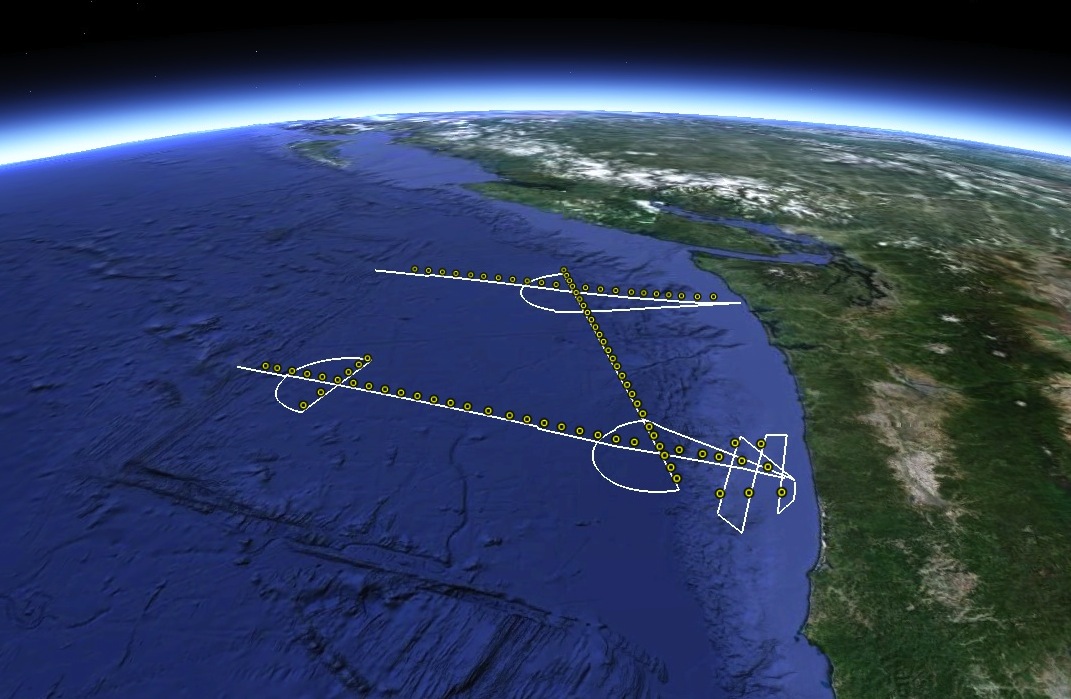Juan de Fuca Plate: From Ridge to Trench
Evolution and Hydration of the Juan de Fuca Crust and Uppermost Mantle: A Plate-Scale Seismic Investigation from Ridge to Trench
Evolution of oceanic lithosphere from formation at the ridge crest to subduction at the trench involves incorporation of water into the physical and chemical structure of the crust and shallow mantle. At subduction zones, water stored and transported with the down-going plate is released at depth through mechanical and metamorphic dehydration. A number of subduction zone processes are affected by de-watering, including partial melting associated with arc magmatism, the mechanical characteristics of the megathrust, and the generation of intraslab earthquakes at intermediate depths. Despite the importance of water bound in oceanic plates for subduction processes, little is known about the extent, evolution, and distribution of plate hydration within the plate interior. At the Cascadia subduction zone, where volcanic eruptions and megathrust and intraslab earthquakes pose significant hazards in the heavily populated northwestern US, the state of the down-going Juan de Fuca (JdF) plate is of particular interest as relatively little hydration of this young oceanic lithosphere is expected. With the presumed warm state of the plate, hydration of the oceanic lithosphere may be confined to the crust, limiting the potential volume of water bound chemically into the plate. However, numerous observations support the abundant presence of water within the subduction zone. In this project we aim to address the following questions in order to understand the contribution of water to subduction zone processes at Cascadia:
(1) How does the JdF plate evolve from ridge to trench and does significant hydration of the lower crust and upper mantle accompany the now well documented evolution of the uppermost crust as the plate ages?
(2) What is the state of hydration of the JdF plate at the Cascadia trench, which represents a young and presumed warm end member for subducting plates?
(3) Do along-trench variations in structure and extent of alteration of the down-going JdF plate contribute to the regional scale variations in structure and seismicity of the Cascadia subduction zone?
In June-July 2012 we conducted a two-ship active source seismic experiment aiming to characterize crustal and shallow mantle velocities and distribution of faulting along two ridge-perpendicular transects spanning the full width of the JdF plate, and a trench-parallel line to characterize along-trench variations in the architecture and velocity structure of the down-going plate across distinct structural regimes of the Cascadia subduction zone.
Expedition OC1206A (RV Oceanus, chief scientist J.P. Canales; co-chief scientist H. Carton) was devoted to the deployment and recovery of ocean bottom seismometers (OBSs).
Expedition MGL1211 (RV Marcus G. Langseth, chief scientist S. Carbotte) conducted long-streamer multichannel seismic (MCS) reflection profiling, and used its air-gun array as a seismic source for the OBSs deployed along wide-angle seismic profiles.

Collaborators
J. Pablo Canales (Woods Hole Oceanographic Institution)
Helen Carton (Lamont-Doherty Earth Observatory)
Mladen Nedimović (Dalhousie University)
Anne Trehu (Oregon State University)
Geoffrey Abers (Lamont-Doherty Earth Observatory)
Download Cruise Reports
Download Vp Models (matlab)
Publications to date
- Han, S., S. M. Carbotte, J. P. Canales, M. R. Nedimović, and H. Carton, (2018),Along-trench structural variations of the subducting Juan de Fuca plate from multichannel seismic reflection imaging, J. Geophys. Res., 123, doi:10.1002/2017JB015059.
- Canales, J. P., S. M. Carbotte, M. R. Nedimović, and H. Carton (2017), Dry Juan de Fuca slab revealed by quantification of water entering Cascadia subduction zone, Nat. Geosci., 10(11), 864-870, doi:10.1038/ngeo3050.
- Han, S., S. M. Carbotte, J. P. Canales, H. Carton, M. R. Nedimović, J. Gibson, and G. Horning (2016), Seismic reflection imaging of the Juan de Fuca plate from ridge to trench; new constraints on the distribution of faulting and evolution of the crust prior to subduction, J. Geophys. Res., 121, doi:10.1002/2015JB012416.
- Horning, G., J. P. Canales, S. M. Carbotte, S. Han, H. Carton, and M. R. Nedimović (2016), A 2-D Tomographic Model of the Juan de Fuca Plate from Accretion at Axial Seamount to Subduction at the Cascadia Margin from an Active Source OBS survey, J. Geophys. Res., 121, doi:10.1002/2016JB013228.
